Is 15 or so miles-per-gallon more worth paying $3,900 more?
It depends.
Right now, the $3,900 more you know you’ll pay to buy the hybrid version of the Elantra – which goes about 15 miles farther overall on a gallon of gas than the non-hybrid Elantra – must be juxtaposed against the right-now cost of gas, which is hovering right around $3 per gallon in most parts of the country.
At that rate, it’ll take awhile to earn back $3,900 in at-the-pump savings.
But what if the cost of gas rises to $4 or $5 per gallon?
Then you’ll know that what you spent on the Elantra hybrid will have been worth a great deal more than you thought it did when you bought it.
What It Is
The Elantra is Hyundai’s compact sedan – which by itself is something of a rarity given how rare sedans are becoming, as crossovers take over the market on their way to becoming the Universal Transportation Appliance.
Even more of a rarity – among new cars in general – is that the Elantra is available with three different engines – and a manual transmission (with two of those engines).
Plus the hybrid drivetrain, too.
Prices start at$19,850 for the base trim SE, which comes with a 2.0 liter four cylinder engine (no turbo) paired with a continuously variable (CVT) automatic.
The high-performance N Line gets a smaller 1.6 liter engine – with a turbocharger, which boosts its output to 201 horsepower. This engine is available with either a six speed manual transmission or a seven speed dual-clutch automatic.
If that’s insufficient performance, the Elantra N (no Line) offers a turbocharged version of the 2.0 liter engine, its output boosted to 286 horsepower, making this version of the Elantra by far the strongest car in this class of car. This engine is also available with either a six speed manual or an eight speed dual clutch automatic.
If it’s maximum mileage you’re after, there’s the hybrid, available in standard Blue ($23,750) and Limited ($28,250) trims. Both come standard with a 139 horsepower version of the 1.6 liter engine – without a turbo – but augmented by a hybrid-electric system that keeps it off as much as possible and thereby boosts the mileage to 53 city, 56 highway.
What’s New
The much-anticipated Elantra N is the main news for 2022.
Otherwise, the Elantra carries over mostly the same as last year.
What’s Good
Manual – or automatic.
Multiple engine options.
Near-motorcycle mileage with the hybrid option.
What’s Not So Good
Manual only available with the two performance engines.
Hybrid’s cost to buy may take awhile to offset via what you save.
Sedan layout limits cargo-carrying capacity vs. hatches and crossovers.
For once, you have something to think about.
Several things to think about.
The Elantra’s standard 2.0 liter engine – which isn’t turbocharged – makes 147 horsepower, is paired with a CVT automatic and delivers 33 MPG in city driving, which is nearly as good as some economy cars manage on the highway.
Where this Hyundai rates 43 MPG – almost as high as some hybrids.
Unfortunately, this engine is automatic (CVT) only, which is part of the reason for its stupendous rated mileage numbers. A CVT will usually give a 3-4 MPG advantage over a manual and 2 or 3 over a conventional automatic with fixed gears and shifts rather than ranges that vary, continuously.
But if you prefer to shift for yourself – and prefer more power – the Elantra offers a 1.6 liter turbo’d four that summons 201 horsepower and your pick of a six speed manual or a seven speed dual clutch automatic. These dual-clutch boxes change gears faster than conventional automatics (which use hydraulic circuits and planetary gears) and so confer both a performance and fuel-efficiency benefit, which is why this version of the Elantra rates 28 MPG in city driving and 36 on the highway with this transmission.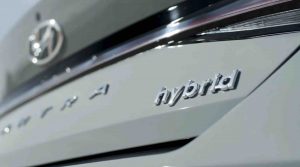
With the manual, the 1.6 engine’s mileage dips a bit, to 25 city, 34 highway.
If you’re after much more power, the new Elantra N (no Line) comes with a 286 horsepower turbocharged version of the 2.0 engine, with N Grin overboost. It can also be paired with either the six speed manual or an eight speed dual clutch automatic. So equipped, this little “economy car” can get to 60 in about 5 seconds, which makes it quicker than practically every V8 muscle car made from the ’60 through the early 2000s.
There is one more thing to think about, however.
It is the hybrid version of the Elantra.
This one has the 1.6 liter engine but without the turbocharger, so it only makes 139 horsepower. But because it is paired with a battery pack/electric motor combo, it can travel more than 600 highway miles on a full tank – which is only 11 gallons (a bit less than the 12.4 gallons other Elantras carry).
The non-hybrid version of the Elantra with the 2.0 liter/CVT combo goes 533 miles on the highway – using about a gallon and a half more gas. Which means the hybrid can go about 150 miles farther on the highway on 11 gallons than the non-hybrid on 12.4 gallons – and much farther in the city, where the hybrid has a much greater efficiency advantage (583 miles on 11 gallons vs. 409 on 12.4 gallons).
At current gas prices – $3 per gallon in my area (VA) when this article was written – the hybrid effectively discounts the cost of a fill-up by about $9 – in terms of having to fill up with less to cover more ground.
That’s not a bad return on your $3,900 investment – even at $3 per gallon. At $4 or $5 per gallon, it could turn out to be a great investment.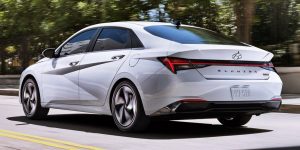
On The Road
Hybrids have a reputation for being slow – because most of the ones people know about are.
That’s you, Toyota Prius.
Then there’s this hybrid.
It gets to 60 in about 9 seconds. It won’t beat a Mustang GT. But it will smoke a Prius, which takes about 11 seconds to get to 60. It’s also about as quick as the typical non-hybrid economy car – or crossover. Which is quick enough to not constantly remind you of the price you pay in a hybrid like the Prius for that motorcycle-like fuel economy.
There are two other related things you might want to know about.
The first is that the hybrid layout eliminates the annoyance of the engine stop-start system almost all new cars now come with that shuts off the engine practically every time the car isn’t moving – and then re-starts it when the car starts moving again.
Or rather, to enable it to move again.
In non-hybrids, this transitioning is noticeable; when the engine cuts off, the car feels off – including accessories like the AC, which are often mechanically driven by the running engine. When the starter cuts on, you hear it and feel it. Often, there is a noticeable pause before the car moves, too – which you’d expect since a non-hybrid car can’t move unless the engine is running.
In a hybrid, off is still on.
The AC continues to run – and the car can still move – even when the engine isn’t running. And to get it running, there is a much larger, much stronger starter – the electric motor – paired with a much stronger, higher voltage battery – to do that without any discernible transitioning.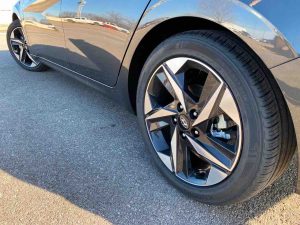
Or delaying.
You’re stopped at a red light. It goes green. You push down on the accelerator. And the car accelerates. Just like any other car. Well, except newer non-hybrid cars equipped with engine stop-start “technology.”
There is one other thing you’ll only notice if you’re not driving (or inside) the Elantra hybrid. You have to be standing outside – to hear it. The first time you hear it, you’ll probably think you or someone nearby left their phone and what you’re hearing is their music. In fact, you’re hearing the music made by the Elantra hybrid. It emits a low, barely audible soundtrack of what sounds just like someone else’s soundtrack – maybe Yanni or Enya synth-pop. It emits it because the Elantra hybrid emits no other sound, when the engine isn’t running. The manufactured sound is to let anyone on foot in the vicinity – who might be too wrapped up in their virtual world to notice the presence of the moving Elantra – know that something is moving in their vicinity.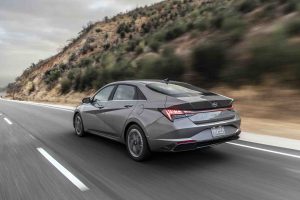
One final thing to know – when you’re moving, again:
This little hybrid also hustles – in the curves. If you want it to. The suspension is much more sporting – or capable of being driven in that manner – than you might expect. Credit for this probably goes to grippier rolling stock – 16×6.5 inch wheels and wider tires vs. the 15-inch wheels/tires that the Prius comes standard with and the Hyundai’s longer wheelbase (107.1 inches vs. 106.3 for the Toyota) as well as its wider track, both of which impart a feeling of greater stability when driving at un-Pruis speeds in the curves.
That plus having almost 20 more horses to pull the car out of the curves than the Prius.
This hybrid also doesn’t look like one.
The Prius made a big deal out of that – with the result being a reputation for virtue signaling. Which is a problem for people who just want to drive – farther, for less. They’ll find this Hyundai appealing on that count, especially since it goes farther than the Prius, which only goes 50 miles on a gallon in city driving and 54 on the highway vs. this Elantra’s 53 in the city and 56 on the highway (and two seconds faster to 60).
And it looks like other Elantras – whereas the Prius looks like every Prius.
It shares the standard Elantra’s sporty sedan profile and its sporty-looking interior, the centerpiece of which is a full-width flatscreen/driver-configurable main gauge cluster. The one thing that is getting less expensive and so more common is digital dashboards, which just a few years ago you generally found only in cars that cost twice as much as this Hyundai costs. The Elantra’s is cantilevered toward the driver, a theme carried over by the similarly angled secondary LCD display and center console, the centerpiece of which is a floating grab handle that extends from the dash area backward.
The drivetrain isn’t all that’s electrically enhanced, either. All hybrid Elantras come standard with heated seats and outside mirrors, dual zone climate control and an upgraded six speaker audio system.
Ventilated seats and leather trim come standard in the Limited trim.
There is also a conventional T-handle gear selector rather than buttons or knobs to push, which adds to the real-car feel of this Hyundai.
The Rest
One price you will pay to own this Hyundai is limited cargo-carrying capacity, a cost incurred by the Elantra’s sedan (with a trunk) layout. It has a good-sized trunk for a small sedan 14.2 cubic feet, which is on par with many mid-sized sedans. But hatchbacks – like the Prius, for instance – have almost twice as much cargo room (27.4 cubic feet) and the crossovers that are quickly becoming the Universal Transportation Appliance often have twice again as much space for cargo in something about the same overall size.
But then, you’d be driving another crossover – or a Prius.
The Bottom Line
The way things are going, hybrids may be the way to go.
. . .
Got a question about cars, Libertarian politics – or anything else? Click on the “ask Eric” link and send ’em in!
If you like what you’ve found here please consider supporting EPautos.
We depend on you to keep the wheels turning!
Our donate button is here.
If you prefer not to use PayPal, our mailing address is:
EPautos
721 Hummingbird Lane SE
Copper Hill, VA 24079
Also, we do accept Crypto. If you’d like to donate that way, please email [email protected] for details.
PS: Get an EPautos magnet or sticker or coaster in return for a $20 or more one-time donation or a $10 or more monthly recurring donation. (Please be sure to tell us you want a magnet or sticker or coaster – and also, provide an address, so we know where to mail the thing!)
My eBook about car buying (new and used) is also available for your favorite price – free! Click here. If that fails, email me at [email protected] and I will send you a copy directly!


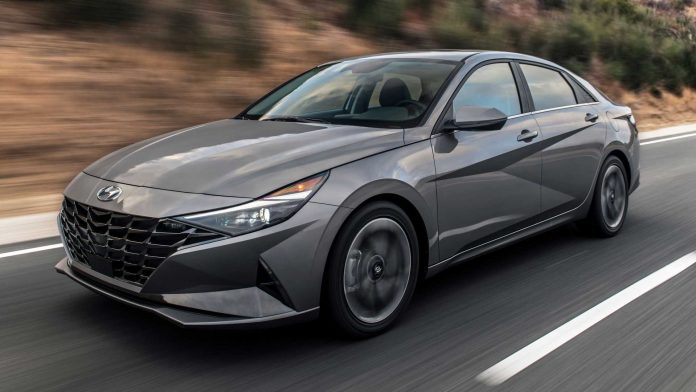

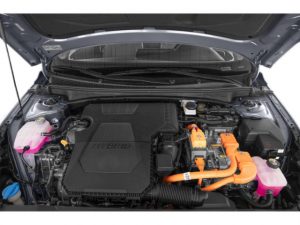
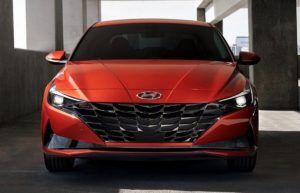








Wow, the N line makes 286 HP, with how much torque??
And how many fedbux??
But the real question is the one we all have…
How high are gasoline prices going to go??
Its $7.59/gal in CA, in some places, and I remember in the 2008 meltdown paying $4.25/gal and being happy in N. VA., and seeing it for 4.50 and 5..25/gal in Arlington and Fairfax.
And that was 13 years ago!!!
Yikes!!!
And we all know this is part of the 2030 agenda, worse yet, and being done to us peons by FEDGOV.!!
I’d take it over the Prius. Especially since it doesn’t come with the virtue signaling exterior.
It’s also not ugly like the Prius. Toyota managed to make an ugly car even more ugly with the last redesign.
Hyundai’s on the other hand have improved design wise over the last ten years.
I agree, Rich – re the Prius – and this little Hyundai is also not un-fun to drive, which counts for a lot to me.